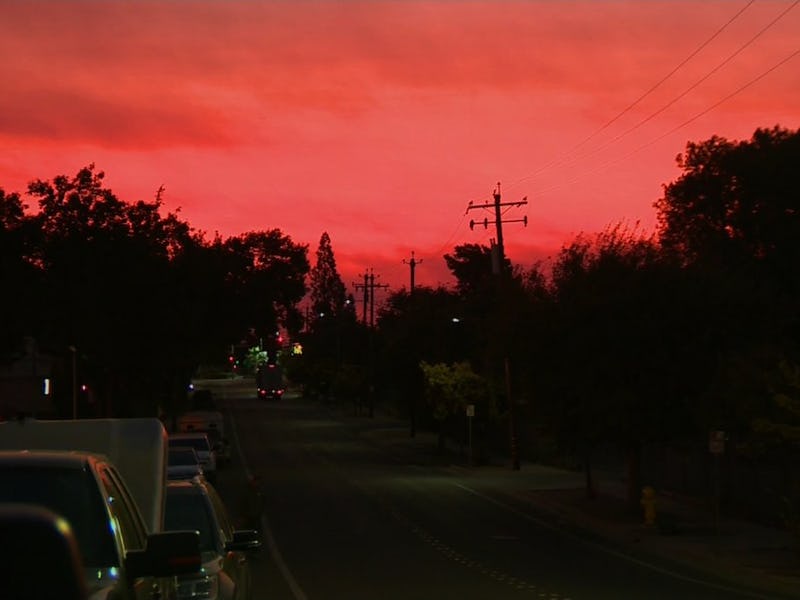Massive California Wildfire Creates Terrifying Red Sunrise
This isn't your average sunrise.

Raging, rapidly spreading wildfires forced up to 20,000 people in Northern California’s wine country out of their homes on Monday. Flames are swiftly consuming houses, commercial buildings, and precious vineyards across Napa, Sonoma, Mendocino, Yuba, Nevada, Butte, Lake, and Calaveras counties, smothering the region in a fog of acrid smoke. As the sun rose through the smoke on Monday morning, the sky glowed bloody red.
The terrifying phenomenon was captured in over Yuba City in a photo by correspondents at the CNN affiliate KCRA News and tweeted out by trained National Weather Service storm spotter, Andrea Butera. In the photo, the sky is the unnaturally bright shade of red normally associated with cherry Slurpees. Some patches of sky further away from the horizon appear pale orange, while others are a muddy violet.
This alarming view is the result of the interplay of sunlight with the occluding smoke from the wildfires. Like the stars we see in the night sky, the true color of the sun’s rays is white, which is evident in photos of the sun taken from space. Its white beams are the result of combining light of all the different wavelengths of the visual spectrum, from long-wavelength red to middle-length green to short indigo.
However, there’s a reason kids grow up drawing yellow suns — and it’s the same reason the sunrise over northern California appeared red today. Usually, as the sun’s white light penetrates the Earth’s atmosphere, it crashes into molecules in the air that cause some of the wavelengths of light within the beam to diffuse.
The sun's light appears white when it's not filtered through the Earth's atmosphere.
During the day, when the sun is high in the sky, the wavelengths that are most often filtered out are short-wavelength colors, like the indigos, purples, and blues. What’s most prominent in the sun’s visible spectrum after this is actually green light, but it’s thought that the scattering of blue light, which makes the sky blue, makes the sun appear yellow in contrast.
When passed through a prism, like the upside-down pyramid of the Louvre, white light scatters into its component colors.
But the number and types of molecules that sunlight is filtered through is dependent on the time of the day and the part of the atmosphere that the light is traveling through. During sunrises and sunsets, when the sun is closest to the horizon, the sun’s light has to travel through a relatively large swath of the Earth’s atmosphere to reach our eyes — and, being close to the ground, a particularly dust-choked one, too. At dusk and dawn, all those particles choke out even more of the short-wavelength light, making the visible yellow, orange, and red rays appear even more enhanced when they reach us.
What’s likely causing California’s blood-red skies is unnaturally high concentration of light-scattering wildfire smoke particles in the atmosphere, which diffuse nearly all of the sun’s light by the time it reaches our eyes — except for its long, red wavelengths. As the sun rises, it doesn’t have to travel through as much smoke, so the garish hue of the light dissipates until sunset begins.